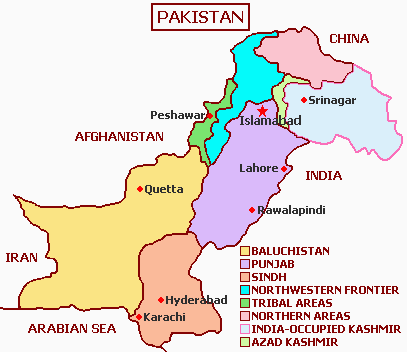
The Khyber Pass, (Pashto: د خیبر درہ, Urdu: درۂ خیبر) (altitude: 1,070 m or 3,510 ft) is a mountain pass that links Pakistan and Afghanistan.
The Pass was an integral part of the ancient Silk Road and throughout history; it has been an important trade route between Central Asia and South Asia and a strategic military location. The summit of the Khyber Pass is 5 kilometers (3.1 mi) inside Pakistan at Landi Kotal and it cuts through the northeastern part of the Safed Koh mountains which themselves are a far southeastern extension of the Hindu kush range.
HISTORY
In some versions of the Aryan migration theory, the Indo-Aryans migrated to India via the Khyber Pass. Recorded invasions through the Khyber begin with the conquests of Darius I and Alexander the Great and also include later Muslim invasions of South Asia, culminating with the establishment of the Mughul Empire from 1526. The British invaded Afghanistan from India and fought three Afghan Wars in 1839-42, 1878-80, and 1919. George Molesworth, a member of the British force of 1919, summarized: "Every stone in the Khyber has been soaked in blood." Rudyard Kipling called it "a sword cut through the mountains."

Afghan chiefs and a British Political officer posed at Jamrud fort at the mouth of the Khyber Pass in 1878.
To the north of the Khyber Pass lies the country of the Mullagori tribe. To the south is Afridi Tirah, while the inhabitants of villages in the Pass itself are Afridi clansmen. Throughout the centuries the Pashtun clans, particularly the Afridis and the Afghan Shinwaris, have regarded the Pass as their own preserve and have levied a toll on travellers for safe conduct. Since this has long been their main source of income, resistance to challenges to the Shinwaris' authority has often been fierce.
For strategic reasons, after the First World War the British built a heavily engineered railway through the Pass. The Khyber Pass Railway from Jamrud, near Peshawar, to the Afghan border near Landi Kutal was opened in 1925.
During World War 11 concrete "dragon’s teeth " (tank obstacles) were erected on the valley floor due to British fears of a German tank invasion of India.
The Pass became widely known to thousands of Westerners and Japanese who traveled it in the days of the Hippie trail, taking a bus or car from Kabul to the Afghan border. At the Pakistani frontier post, travellers were advised not to wander away from the road, as the location was then a barely controlled Federally Administered Tribal Area. Then, after customs formalities, a quick daylight drive through the Pass was made. Monuments left by British Army units, as well as hillside forts, could be viewed from the highway.
The area of the Khyber Pass has been connected with a counterfeit arms industry, making various types of weapons known to gun collectors as Khyber Pass Copies, using local steel and blacksmith’s forges .
CURRENT CONFLICTS

Khyber Pass
During the current war in Afghanistan, the Khyber Pass has been a major route for resupplying NATO forces in the Afghan theater of conflict. Recognizing this, the Taliban attempted to choke off the route in late 2008 and early 2009, bringing the Taliban into conflict with the Pakistani government.
In February 2009, a bridge 15 miles northwest of Peshawar was blown up by militants presumably sympathetic to or sponsored by the Taliban. While it was not considered to be a major strategic blow to the allied war effort, it invigorated efforts to secure additional supply routes, some of which may ultimately run through Iran. However, the current general consensus is that the new supply route will pass through various central Asian republics to the north of Afghanistan.
CONQUERORS AND GENERALS
The commanders who crossed the Khyber Pass all led armies eastward in the conquest of India, except for Chandragupta Maurya ,Ranjit Singh, George Pollock and Sir Donald Stewart who crossed in the opposite direction.
Cyrus the Great Tamerlane
Alexander the Great Babur the Tiger
Chandragupta Ranjit Singh
Demetrius 1 of Bactria Humanyun
Mehmud Ghaznavi Shah Jahan
Muhammad Ghori Nader Shah Afshar
Genghis Khan Ahmed Shah Durrani
Qutlagh khwaja George Pollock Sir Donald Stewart,1st Baronet








































































































































